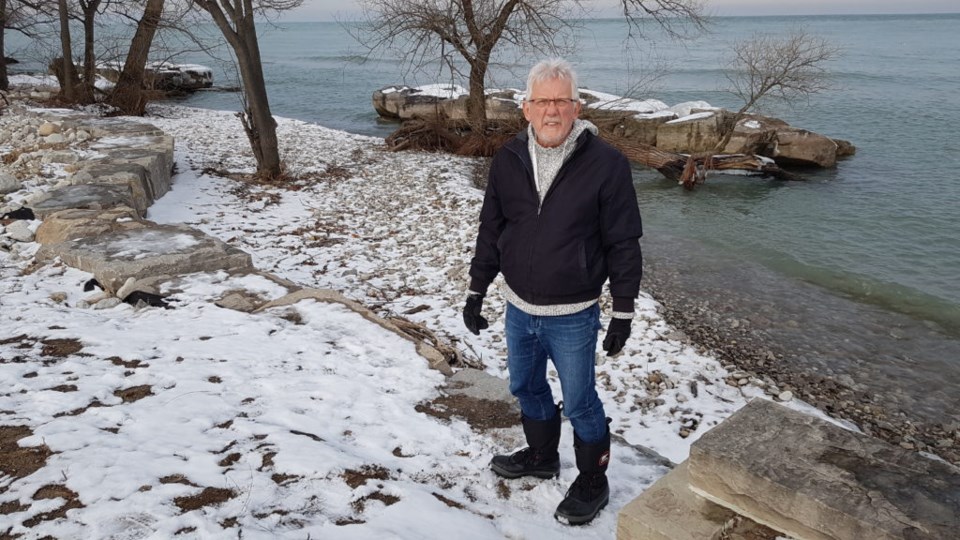
Standing in the Dock Area parkette, waves washing up to shore, it’s not hard to sense the urgency projected by local Ron Simkus.
With his background as a mining engineer, for more than a year the Ball Street resident has taken it upon himself to send out email blasts to about 100 people, including in the U.S. and throughout Ontario, to share data about the water level of the lake and explain what it means.
These days, his concern is evident, although not for himself — his home sits higher than others in his neighbourhood, and was designed and built to withstand any flooding that might occur in the area.
The water elevation at the end of last week was 246.33 feet — exactly what it was last year on April 14, and only three inches lower than the all-time high for January, set in 1946. It was nine inches higher on Jan. 22 than it was on the same day last year.
Last week, Lake Superior was at its record high, set in January 1986, and Lakes Michigan and Huron were five inches higher than their 1987 record.
This does not bode well for what is to come, “and we have to accept that it’s coming,” he says. “We’re in much worse shape now than we were last year.”
When he speaks about what he fears may occur, he is clear, as has been Town environmental supervisor Brett Ruck, that there are two separate issues of concern.
The immediate issue is shoreline stabilization on public property, says Simkus. The other is flooding, which, while it affects private property, can be mitigated by Town actions.
His sense of urgency is related to the need to move quickly on shoreline protection. The materials — about 100 large, expensive anchor stones, boulders and cobble — have been piled in the parkette since purchased in the spring of 2018, but the work was put on hold while the Town waited for a provincial permit.
That was received in October, 2019, after some confusion with the provincial and local office looking after such permits, Ruck explained to councillors at a recent update. He’s been keeping them abreast of the waterfront situation, and ensuring residents as well are kept up-to-date.
The permit is for two steps, one in the water and one on the shore. The in-water portion has to be completed before March, when fish spawning begins, or it will have to wait until July. Ruck has said he sees no problem in getting the in-water groyne constructed in time, before he moves on to the ground installation.
According to a Town information report he released last Thursday, the groyne installation, which involves placing anchor stone in the water to create a small peninsula at an angle to the shore, will take about two weeks.
The partial burying of more anchor stone on shore, placing cobble along the shoreline to protect it, is expected to follow, and the Town has been preparing a tender to solicit bids and get the work going.
The groyne acts like a breakwater, says Simkus, and the anchor stone on shore creates a little wall, to stop soil from sloughing into the lake when the waves wash over it and travel back to the lake.
It won’t stop flooding, but it will protect the shoreline, he says.
Last year, when the water level rose, large bladders were placed along the shoreline to do the work the wall will do once it’s installed, Simkus says.
At this point, the information report to council says, those two projects alone are estimated to cost about $160,000. To date, the report states, there is $128,000 in the 2020 budget. “Discussions around how this is to be funded will be addressed in the new future as there are a number of ways this can be approached,” Ruck says in his report to council.
The residents have been living with the mess in the parkette for a long time, and will be pleased to see it completed, says Simkus.
Other work to be completed on the parkette, including more shoreline stabilization and flooding protection for low-lying areas, including a much-discussed rain garden to collect water, is estimated to cost about $300,00. Adding work that needs to be done to Riverbeach Park, Melville Street, Nelson Street Park and the wall in front of the Niagara Pumphouse Arts Centre, which the Town hasn’t yet addressed, brings the estimated cost to well over $1 million.
But the immediate concern, creating his sense of urgency, says Simkus, is the rising water level expected in the spring, which will present serious challenges, quite likely worse than last year. He is calling what’s to come “a knockout, drag-down season. And the guys on the U.S. side are echoing the same message.”
Just one inch over last year’s high water level could cause serious flooding, says Simkus, pointing in the direction of Melville Street, where the water would break out from the sailing club, and travel down toward some Dock Area homes on Lockhart. At that point, it would just be a matter of how much damage it would cause, he says.
There wouldn’t be anything the Town could do to stop it, other than emergency planning for evacuation, he says.
And the sooner the Town completes the shoreline protection work, the more ready it will be to focus on flooding if — or as he fears, when — it occurs this spring.